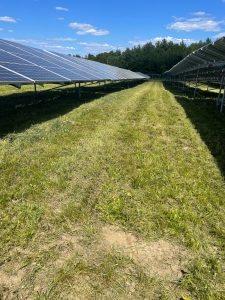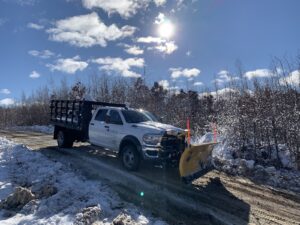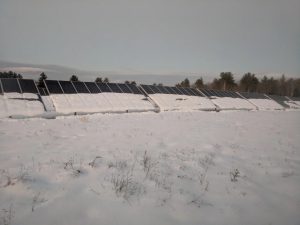
A growing trend throughout New England and neighboring states this year is the existence and growth of an invasive plant called Reynoutria japonica or more commonly known as Japanese Knotweed; seen in photo 1A.
This type of vegetation is known as the world’s top 100 invasive species and it may be taking over your solar farm this season. In the early Spring this plant can be as small as 4cm high but by mid June it can grow up to 32ft, towering over panels and causing electrical hazards to your modules.
Unlike most invasive species, Japanese Knotweed not only holds a threat to solar modules but can also grow through concrete, TARMAC, and drains ultimately causing severe damage to access roads and buildings.
Photo 1A shows one way knotweed can enter your solar farm, the fence-line. This photo also helps understand why fence-line maintenance is crucial to vegetation management.

“Can I cut Japanese Knotweed?”
No! Unlike other vegetation, knotweed thrives on being cut or mowed over. A trimmed piece of this plant as small as .7g (smaller than a fingernail) can re-root and grow into an entirely new infestation in a matter of weeks. This plant is also immune to fires and can quite literally rise from the ashes.
Photo 1B shows an example of how knotweed can grow and wrap around solar arrays and electrical wires causing fire hazards.

“Is it poisonous to humans?”
Japanese Knotweed is fortunately not harmful to humans, however, there have been some reports of a small irritation from skin to plant contact without proper PPE on. This irritation typically goes away on it’s own within a few days.
Due to its many forms during the Spring, Summer, and Fall Japanese Knotweed can oftentimes be hard to diagnose and is commonly confused with Giant Hogweed which is harmful to humans.
Photo 1C shows the most common visual of what Japanese Knotweed can look like in the Spring and Summer months.

How to Treat Japanese Knotweed
Although it seems as if this invasive species is immune to all forms of treatment. Donahue & Sons recommends
speaking with a professional in your state to effectively and safely remove this plant from your commercial solar farm.
Luckily for our clients in Massachusetts, Rhode Island, and Vermont we have trained and licensed crew members on standby to treat this problem with effective pesticides and get your solar farm set up for success this vegetation season!
Not sure if your solar farm may have a knotweed infestation? Send us a photo and our team would be happy to diagnose and set up a treatment plan that works for your company.
Photo 1D shows the comparison in length at the beginning of May 2021 to a team member at 67 inches tall. Knotweed ranges at shoulder length in some parts of this solar farm BEFORE the Summer months.





